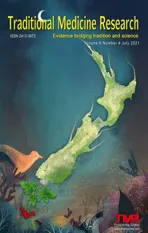System pharmacology-based dissection of the potential effective material basis and mechanism of Xiaoxianxiong decoction for type 2 diabetes mellitus
2021-07-07JiaoKongChuanXinLiuJiaLiZhouYouZhiLiXiXiCuiTaoHeBaoNanMaShuangHanYiNingZhangJianMeiHuang
Jiao Kong ,Chuan-Xin Liu ,Jia-Li Zhou,You-Zhi Li,Xi-Xi Cui,Tao He,Bao-Nan Ma,Shuang Han,Yi-Ning Zhang,Jian-Mei Huang*
1School of Chinese Materia Medica,Beijing University of Chinese Medicine,Beijing 102488,China.
Abstract Background:Xiaoxianxiong decoction is a classic formula in traditional Chinese medicine used to treat type 2 diabetes mellitus and proven to be effective.But the material basis and underlying mechanisms remain unclear.The aim of the present study was to elucidate the potential effective material basis of Xiaoxianxiong decoction and molecular mechanism treating type 2 diabetes mellitus.Methods:The absorbed bioactive components were identified based on serum pharmacochemistry.Network analysis were performed to obtain effect targets for docking verification with the absorbed prototypes to determine the potential effective material basis.On the above basis,network pharmacology was conducted to explore the molecular mechanism.Results:76 compounds were identified of Xiaoxianxiong decoction and 61 absorbed bioactive compounds were investigated.Serine/threonine kinase 1 and ALB were key targets acquired by network analysis for molecular docking.Subsequently,5 compounds were considered as the potential effective material basis,namely berberine,berberrubine,lariciresinol and gingerenone A,jatrorrhizine.Further,the mechanism mainly lies in the insulin signaling pathway,HIF-1 signaling pathway,PI3K-Akt signaling pathway,FoxO signaling pathway,AGE-RAGE signaling pathway in diabetic complications,phospholipase D signaling pathway to regulate blood glucose levels on target tissues as well as organs and exhibit anti-inflammatory,promote cell differentiation and cell growth,maintain oxygen homeostasis and affect the enzymes along with key metabolites.Conclusion:This integrated research strategy to investigate the treatment of Xiaoxianxiong decoction on type 2 diabetes mellitus provides valuable insights for further study and clinical practice of Xiaoxianxiong decoction.
Keywords:Xiaoxianxiong decoction,Type 2 diabetes mellitus,Material basis,Molecular mechanism,Berberrubine,Serine/threonine kinase 1
Background
Type 2 diabetes mellitus(T2DM)is a common complicated metabolic syndrome which seriously affects patient’s life and quality of life,and also results in heavy burden of society[1].The International Diabetes Federation estimates that in 2035 the number of people with diabetes in the world will increase to 592 million[2].Chronic hyperglycemia and glucose metabolism disorder,characteristic clinical symptoms of T2DM,often lead to severe complications that may include neuropathy,retinopathy,atherosclerosis and nephropathy[3].At present,repaglinide,metformin and insulin have been used clinically in the treatment of T2DM to effectively control blood glucose level and prevent complications[2].Nevertheless,prolonged use can be addictive and cause many adverse reactions,including gastrointestinal discomfort,hypoglycemia and so on[4].Therefore,there is a general trend to apply traditional Chinese medicine(TCM)which characterized as“wholism”and“syndrome differentiation”to the treatment of T2DM with fewer side effects and stable curative effect[5].
Xiaoxianxiong decoction(XXXD)is a classical formula first recorded inTreatise on Cold Pathogenic and Miscellaneous Diseases(205 C.E.)written by Zhong-Jing Zhang,and consists of three herbal medicines,including Huanglian(Coptidis rhizoma),Banxia(Pinellia rhizome)and Gualou(Trichosanthis fructus).It is the most recognized TCM formula to treat“minor accumulation of chest”disease,which has the closest clinical manifestation with bacterial pneumonia in modern medicine,caused by mutual interaction of phlegm and heat(the pathogenic products in TCM theory)in the heart,which the notably curative effect is widely acknowledged by thousands of clinical application[6].Modern pharmacological research shows that XXXD was applied to treat T2DM with blood glucose(BG),glycosylated hemoglobin(HbA1c)and inflammatory factors such as tumor necrosis factor-α and interleukin-6 significantly reduced as well as clinical symptoms apparently improved[7,8].Furthermore,Zhang[9]found that XXXD can significantly improve the insulin resistance index of prediabetic patients,protect the cells,and control the development of diabetes.Although it can be deduced that the pharmacological effect and hypoglycemic effect of XXXD is distinct,very little is realized about its systematic chemical constituents,and the effective material basis as well as its mechanism that account for its therapeutic effects remain unknown.
Serum pharmacochemistry is a rapid and effective tool using the ultra-performance liquid chromatography-mass spectrometry (UPLC-MS)technology to follow the trail of the constituents absorbed into blood and has been widely used to clarify the efficacy of TCMs[10].TCM serum pharmacochemistry was proposed by Wang et al.in 2002[11],which believes that the components will be effective only if they are absorbed into the blood.This method has been widely applied to figure out the material basis of TCM.The material basis of Shenfu decoction(classic ancient prescription)and Sanzi Guben granule(empirical formula of Chinese medicine)were identified by using the method of TCM serum pharmacochemistry[12,13].
Bioinformatics aims to comprehend and clarify the biological significance of large amount of bioinformatic data[14],including molecular docking and serum pharmacochemistry,which can be used to explore potential disease targets of genes related to metabolic diseases such as type 2 diabetes[15].For example,Wang et al.[16]gained 15 potential inhibitors of protease-activated receptor by molecular docking;Chen et al.[17]found that a variety of flavonoids and alkaloids were inhibitors of α-glucosidase using molecular docking;Chen et al.[18]learned the mechanism related to anti-cancer effect by docking between Fuzheng Yiliu formula(empirical formula of Chinese medicine)and epidermal growth factor receptor,vascular endothelial growth factor,cyclin dependent protein kinase,focal adhesion kinase,farnesyl transferase and anti-apoptosis genes.It can be inferred that intersection of serum pharmacochemistry and molecular docking is an effective way to discuss the effective material basis of TCM.
Network pharmacology was proposed by Hopkins in 2007,which has been a powerful tool in interpreting integral mechanisms of TCM formula coinciding with the“wholism”in TCM.The active ingredients and antiallergic rhinitis mechanism of Mahuang Fuzi Xixin decoction(classic ancient prescription)were explored by drug target prediction and network analysis[19].Xiao et al.[20]investigated the targets of active ingredients and molecular mechanism of Liuwei Dihuang pill(Chinese patent drugs,approved number Z53020522)which explained the principle of“simultaneous treatment of different diseases”,and noticed the new role of preventing diseases from developing from inflammation to cancer.
In present work,an integrated systematic pharmacology method combining serum pharmacochemistry and network pharmacology was proposed to demonstrate the effective material basis and potential mechanism of XXXD on T2DM,thereby providing valuable insights for further study and clinical practice of XXXD.The flowchart of the research process is illustrated in Figure 1.
Materials and methods
Equipments,drugs and reagentsd
Coptidis rhizomaandTrichosanthis fructus.were purchased from Yongshengtang Pharmaceutical Chain Co.,Ltd.(Beijing,China),andPinellia rhizome[21]was purchasedfrom Anguo Chinese Herbal Medicine Market(Hebei,China).Botanical materials were authenticated by Professor Jian-Mei Hang,the chairman of department of TCM analysis of Beijing University of Chinese Medicine. Liquid chromatography-mass spectrometry(LC-MS)grade acetonitrile,methanol formic acid were supplied by Thermo-Fisher(USA),Chloral hydrate(302-17-0,Innochem Technology Co.,Ltd.,China)was purchased from Beijing Innochem Technology Co.,Ltd.Ultra-pure water for LC-MS analysis was obtained by a Milli-Q Integral water purification system(Millipore,USA).MassLynx(V4.1 SCN916,USA)was used for mass spectrometer workstation.
Sample preparation
Preparation of XXXD samples in vitro.Coptidis rhizoma,Trichosanthis fructus.andPinellia rhizomewere mixed together with 6:12:20(by weight),and macerated in distilled water for 1 hour before being decocted.The extraction process was performed by decocting with 10-fold and 8-fold volume of solvent for 2 times and 1 hour for each.The filtrate was filtered and combined.Then the filtrate was concentrated to prepare the orally administered solution at a concentration of 4 g/mL.The different doses of XXXD were prepared by distilled water at the time of use.Finally,2 mL of the mixture was centrifuged at 12,000 rpm for 15 min,and 300 μL of the supernatant was transferred to a sampling vial for UPLC-Q-TOF/HRMS(ACQUITY I-CLASS,SNAPT G2-SI Q-TOF,Waters,USA)analysis.
Animals handling.Male Wistar rats(n=18),weighed(250±20)g,were purchased from Beijing Vital River Laboratory Animal Technology Co.,Ltd.(Beijing,China),with an approval number SCXK(Beijing)-2016-0011.All the rats were maintained on the Experimental Animal Room of Liangxiang Campus of Beijing University of Chinese Medicine,with a 12 hours light/dark cycle at(23±2)°C and(35±5)%humidity.The animals were acclimatized to one week prior to the experiment.After accommodation,the rats were randomly divided into three groups(n=6):control group(NS),small dose of XXXD group(XXX-S),large dose of XXXD group(XXX-L).The study was approved by the Ethical Committee of Beijing University of Chinese Medicine and the study was conducted conformed to the Care and Use of Laboratory Animals published by the National Institutes of Health (approval number:BUCM-4-2019120101-4112).
Sample collection and preparation.All animals were fasted for 12 hours before administration but free to water.According to Professor Tong’s[8]clinical study of XXXD in the treatment of diabetes,the smallest and largest daily dose ofCoptis chinensis,Pinellia ternateandTrichosanthes kirilowiiwere 30g,15g,15g and 45g,30g,30g.When converted into rats,it was 9.45g(crude drug)/kg(body weight)and 13.23 g/kg respectively.There is a certain correlation between the measurability of components and the dosage.Therefore,the intermediate dose 10 g/kg between 9.45 g/kg and 13.23 g/kg was considered as the small-dose group,and twice the small dose 20 g/kg was considered as the large-dose group at the same time.XXX-L group was intragastric administration 20 g/kg body weight of XXXD sample once.XXX-S group was intragastric administration 10 g/kg body weight of XXXD sample once.NS group was intragastric administration with an equivalent volume of distilled water.Blood sample were collected via the abdominal aorta 1 hour after the administration.Then,samples were centrifuged at 3,000 rpm for 15 min at 4 °C.The supernatants were centrifuged it at 3,500 rpm for 8 min at 4 °C.All samples were stored in a refrigerator at-80°C until analysis.
The blank serum samples and drug-containing serum samples of six rats in three groups were mixed in advance.In order to facilitate the detection of components in serum samples,double concentration(2:1)and quadruple concentration(4:1)were performed.Three times acetonitrile was added to the 200 μL and 400 μL serum samples,respectively,with ultrasonic treatment in ice water bath for 10 min subsequently,vortexed and then,centrifugated at 12,000 rpm for 15 min at 4 °C.The supernatant was dried with nitrogen gas in water bath at 37 °C.The residue was redissolved in 100 μL methanol and centrifugated at 12,000 rpm for 15 min at 4°C,and the filtrate was analyzed by UPLC-Q-TOF/HRMS(ACQUITY I-CLASS,SNAPT G2-SI Q-TOF,Waters,USA).
Instrumentation and conditions
UPLC-Q-TOF/HRMS analysis conditions.Chromatographic system was employed with ACQUITY UPLC BEH C18 column(2.1 mm×100 mm,1.7 μm,0300371911,Waters,USA)maintained at 40 °C and the injection volume was 5 μL with Masslynx workstation(V4.1,USA).The mobile phase consisted of 0.1%formic acid-water(v/v,A)and 0.1%formic acid-acetonitrile(v/v,B)was used at a flow rate of 0.3 mL/min.The optimal gradient elution system was as follows:2%-60% B(0-14 min);60%-98% B(14-16.5 min);98%B(16.5 min-18 min);98%-2%B(18-20 min).
Mass spectrometry conditions.The high-resolution ion-opening mass spectrometer(SNAPT G2-Si Q-TOF,Waters,USA)electrospray ionization source ESI was selected for mass spectrometry detection in positive(ESI+)and negative ion(ESI-)modes.High purity N2was used as an auxiliary spray ionization and desolvation gas.The drying gas flow rate is 10 mL/min;the N2temperature is 120 °C;the atomizing gas pressure is 310 kPa;the desolventizing nitrogen flow rate is 900 L/h;the cone hole back blowing nitrogen is 50 L/h;the capillary ionization voltage is 500 V;The cone voltage is 40 V;the collision energy is 40-65 eV;the quadrupole scan range is 50-1,200 Da.UNIFITM(Scientific Information System V8.1,Waters,USA)software was used for constituent identification of TCM formulae in vitro and in vivo.
Data analysis
Establishment of XXXD database.By searching databases,the Traditional Chinese Medicine Systems Pharmacology Database and Analysis Platform(TCMSP) (http://lsp.nwu.edu.cn/tcmsp.php) and Chinese National Knowledge Infrastructure(CNKI)(https://www.cnki.net/)[22-27],all components reported in these databases onTrichosanthis fructus.,Coptidis rhizoma,Pinellia rhizomewere summarized and uploaded to ChemSpider(http://www.chemSpider.com/default.aspx) and Chemical Book(https://www.chemicalbook.com/ProductIndex.aspx)to establish a database,which includes the name and chemical structure file in mol format of known chemical compositions inTrichosanthis fructus.,Coptidis rhizoma,Pinellia rhizome.
We identified and analyzed the existing chemical substances relying on the UNIFITM software(Scientific Information System V8.1,Waters,USA)and the RAW format files collected by MassLynx software also should be imported into a suitable data storage folder.Then select the exact mass screening of MSe data and set the threshold ratio of the high energy channel to 40 and the threshold ratio of the low energy channel to 300.To run the fragment analysis,in the positive ion mode,we select the relevant additive ions as+H,+Na,+K,+NH4,and-H,+Cl,+CH3COO,+HCOO in the negative ion mode.The locked mass value is set to correct the mass,the positive ion is 556.2766,the negative ion is 554.2620,and other values are defaulted.Finally set the components that show good matching,and define that there is at least one high-energy ion fragment and the absolute value of the error does not exceed 10 ppm.At the same time,compounds comparison and identification based on the previous literature in CNKI and mass spectra are also performed.
Establishment of prototypes database of XXXD in vivo.By searching names and chemical structure files in XXXD database to establish the prototypes database used for metabolite analysis.
Network pharmacology-based analysis
“Prototypes-targets(P-T)”fishing.The theory of serum pharmacochemistry claims that the main active components may be those absorbed in the serum.The 2D structures of prototype compounds were downloaded by PubChem(https://pubchem.ncbi.nlm.nih.gov/)and transformed into MOL2 format.Further,PharmMapper Server(http://www.lilab-ecust.cn/pharmmapper/) database were employed to obtain the targets of the active ingredients,which is the web server for potential drug target recognition using pharmacophore mapping.With the reverse molecular docking score fit score value as the standard,the first 100 targets with high scores more than 0.4 of the pharmacophore matching of prototypes were determined.Additionally,the targets were also identified by databases,the Swiss Target Prediction database(http://www.swisstarg etprediction.ch/) and BATMAN-TCM(http://bionet.ncpsb.org/batman-tcm/index.php/Home/I ndex/index).All targets were integrated and deduplicated,and all of“Homo sapiens”.
“T2DM-targets(T-T)”obtaining.The related disease targets were searched and analyzed by inputting the key word“Diabetes Mellitus,Type 2”into Therapeutic Target Database (TTD,https://db.idrblab.org/ttd/), Comparative Toxicogenomics Database(CTD,http://ctdbase.org/)and GeneCards(https://genecards.weizmann.ac.il/v3/)database.The 81 targets in TTD database were all included, but only the targets marked“marker/mechanism”and“therapeutic”were selected in CTD database,and the correlation scores greater than 9 were selected in GeneCards.Then the targets were integrated and duplication were deleted withHomo sapienslimit annotation selected.
Construction of interaction network.The P-T targets and T-T targets were intersected to obtain common targets of XXXD treating T2DM.The common targets were uploaded to STRING database(https://string-db.org/)for protein-protein interaction(PPI)analysis and visualized by Cytoscape 3.7.2.The“degree”and“combined scores”parameters of targets were used to demonstrate the topological importance of nodes to link the action of XXXD with T2DM.The target with degree≥30 and combined scores≥0.4 should be considered as key target.We will obtain a visualized network processed by Cytoscape(V3.7.2,National Institute of General Medical Sciences,Piet Molenaar),where nodes represent target proteins,edges represent interactions between target proteins,and node size and color represent degree size,the thickness of the edge indicates the combine score.The larger the node,the brighter the color,the greater the degree value,the thicker the edge,the greater the combine score value;C-E:diagram of key molecular docking mode of XXXD in blood and positive drug prevention and treatment of T2DM.
Molecular docking verification
Preparation of small ligands.The chemical structure of prototypes were downloaded from the ZINC(http://zinc.docking.org/)database and saved as MOL2 format files.Small ligands were pretreated by AutoDockTools software(V1.5.6,Molecular Graphics Laboratory,Sargis Dallakyan),including the addition of hydrogen atoms,Root,and setting compute Gasteiger,then saved as PDBQT format file.
Preparation of receptors for docking.The crystal structures of protein receptors were retrieved from RCSB PDB(http://www.rcsb.org/)protein database.For the receptor containing multiple crystal structures,we selected targets with high resolution and a complex substance.These ligands were pretreated utilizing“PymolWin”software and“AutoDockTool 1.5.6”software to(1)remove solvent and originally organic ligands;(2)add Hydrogens;(3)set Compute Gasteiger.After the procedures described above,the proteins were saved as PDBQT format files.
Molecular docking analysis.The molecular docking was performed using AutoDockTool 1.5.6 software(V1.5.6,Molecular Graphics Laboratory,Sargis Dallakyan),the AutoDock parameters used were as follows:(1)grid size and parameters are set by AutoGrid;(2)the Lamarckian genetic algorithm is executed to predict the best binding position;(3)the experimental calculation of molecular docking is carried out by running AutoDock.After docking,ΔGbind was chosen as the scoring standard based on binding energy.The smaller the valueΔGbindand Ki,the stronger the binding capacity of the receptors to the ligands.Additionally,the docking results should be compared with the positive drugs,fomepizole,acarbose,and repaglinide.
Analysis of the molecular mechanism
Direct targets fishing.The“P-T”targets has been determined previously,so the target of the metabolites were introduced into PharmMapper(http://www.lilab-ecust.cn/pharmmapper/) for prediction.The“P-T”targets and the targets of metabolites were combined,deduplicated and uploaded to protein database UniProt(https://www.uniprot.org/)to convert the targets into the corresponding standard gene name inHomo sapiens.Therefore,we could obtain direct targets with scores more than 0.4(targets of effective material basis)for pathway analysis.
Direct consensus targets and indirect targets obtaining.The direct targets and the“P-T”were intersected to obtain the direct consensus targets(targets of XXXD against T2DM).These direct consensus targets obtained above were imported into the GeneMANIA(https://genemania.org/)database with species setting as Homo sapiens,downloaded Genes data and deleted direct consensus targets to gain indirect targets.
Gene Ontology(GO)bioanalysis and pathway analysis.All direct consensus targets and indirect targets were integrated and uploaded to the STRING 11.0 database and saved as TSV format files for GO analysis including three aspects,Biological Process,Cellular Component and Molecular Function,Kyoto Encyclopedia of Genes and Genomes(KEGG)pathway analysis and Reactome pathway analysis.And its PPI network was visualized by Cytoscape 3.7.2.
GraphPad Prism5 software was used to draw the GO analysis diagram of the top 10 with low false discovery rate. Furthermore, Omicshare website(http://www.omicshare.com/tools/index.php/) was used to visualize the pathway analysis.At the same time,extensive pathways were excluded,and the top 30 pathways with low false discovery rate in KEGG pathways and Reactome pathways were selected and imported into the Omicshare database to draw pathway analysis diagrams.Last but not least,Reactome database was applied to draw the biological function analysis map of potential targets of XXXD with therapeutic effect for T2DM.
Construction of“TCM formula-herb-chemical composition-absorbed chemical constituent-direct target-indirect target-pathway”network.The TCM formulae and the life system are both complex systems.To examine the concrete mechanism of XXXD entering human body and reveal the reliable relationship of“XXXD-human body”,“TCM formula-herb-chemical composition-absorbed chemical constituent-direct target-indirect target-pathway”network were constructed using Cytoscape 3.7.2.
Results
Characterization of chemical compositions of extracted XXXD
Masslynx V4.1 was used for acquiring MS(mass spectrometry)data,indicating the retention time and precise molecular,providing the MS2(the secondary mass spectrometry)data.The base peak chromatogram of XXXD extract samples in positive ion(ESI+)and negative ion(ESI-)mode,as shown in Figure 2.With an advanced data analysis software(UNIFITM),the ion information in high and low energy mode would be obtained comprehensively.As far as the ion addition form,we deduced a common knowledge of+H/+Na/+K/+NH4(in positive ion mode)or-H/+Cl/+CH3COO/+HCOO(in negative ion mode).
In result,a total of 76 compounds were tentatively characterized based on their chromatographic and spectrometric data.Compound 36th was taken as an example,its MS2spectra(molecular ion at m/z 337.1284[M+H]+)in Table S1 gave characteristic fragment ions of[M-CH4]+at m/z 320.0839 and[M-CH4-C2H2O]+at m/z 278.0802.Therefore,it corresponded to berberine by comparison with database via UNIFITM,details are shown in Figure S1.Moreover,the majority of components are identified as alkaloids,flavonoids,with their deriving herb for each assigned.
Identification of the absorbed chemical constituents in rat serum
The absorbed bioactive prototype constituents.Compounds absorbed in blood were identified via UNIFTMsoftware,which is characterized by comparing thetRvalues and MS2fragmentations between compounds in serum and compounds in XXXD extract.The data compared was founded on the XXXD database established previously and the matching compounds as well as the corresponding fragments were acquired(Table 1).Then we employed the UNIFI platform to automatically search absorbed constituents with precise MS2data based on the database of XXXD.Moreover,we also checked the reliable molecular fragmentation andtRvalue.Ultimately,six prototypes were determined.One compound sourced fromPinellia rhizomewas identified as gingerenone A.MS2spectra of compound gingerenone A in Table S1 was detected with thetRvalue at 17.41 min and gave the chemical formula C21H24O5and precise molecular weight 356.1624 in negative ion mode.Similarly,MS2spectra of compound 5 in Table 1 was detected at thetRvalue in 17.75 min and gave the same formula and precise molecular weight.Therefore,compound 5 in Table 1 was identified as the absorbed bioactive prototype of gingerenone A in rat serum.Likewise,three components sourced fromCoptidis rhizomawere identified,namely,lariciresinol,berberrubine and berberine and two components sourced fromTrichosanthis fructus.were identified,namely,1,4-D-Galactonolactone,cucurbitacin B,which were in accordance with the components in herb marked with“#”in Table S1.
The absorbed bioactive metabolites.UNIFITMplatform was employed to characterize the metabolites of prototypes,covering six metabolic pathways that is phase I metabolism reduction, oxidation,decarbonylation,hydrolysis,and phase II metabolism,sulfation,glucuronidation.With the above conditions,the elemental compositions and molecular weights of metabolites derived from prototypes can be readily predicted.In total,55 metabolites were determined in the serum containing drugs.All the identified MS data of metabolites were displayed in Table S2.Alkaloid-related metabolites are the main metabolic ingradients of XXXD absorbed in vivo,and the metabolic pathways in vivo were sulfation(+SO3)and Glucuronidation(+C6H8O6).Based on research literature,M44 in Table S2 was identified as jatrorrhizine sourced from based berberine on accurate molecular weight and fragmentation rules[28].
Network analysis results
Prediction of common targets.Using the previous database of pharmacophore matching and potential target recognition,a total of 404“P-T”targets of the six bioactive absorbed prototypes were predicted.In addition,a total of 390“T-T”targets were obtained including 81 disease targets in the TTD database,236 disease targets in the CTD database,and 134 disease targets in the Genecards database and merged as well as de-duplicated.Then 38 common targets were obtained by intersecting“P-T”targets and“T-T”targets targets,as shown in Figure 3A.
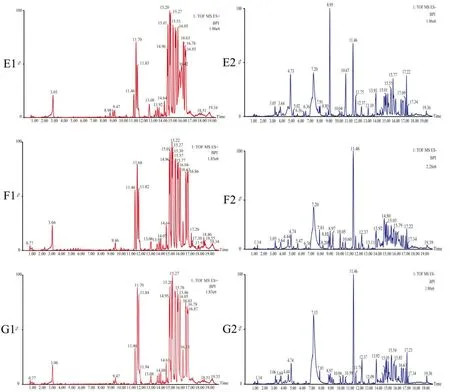
Figure 2 Base peak chromatogram of drug-containing and blank serum of XXXD(Continued).1,ESI+;2,ESI-;A,base peak chromatogram of XXXD;B,control group 2:1 concentration;C,small-dose group of XXXD 2:1 concentration;D,large-dose group of XXXD 2:1 concentration;E,control group 4:1 concentration;F,small-dose group of XXXD 4:1 concentration;G,large-dose group of XXXD 4:1 concentration.XXXD,Xiaoxianxiong decoction.
Construction of interaction network.38 common targets were used for construction of PPI network in STRING database,and uploaded to Cytoscape3.7.2 for visualization,involving 36 nodes and 200 edges in total,as shown in Figure 3B.The first two targets with high Degree value were serine/threonine kinase 1(AKT1),serum albumin(ALB),as key targets for the treatment of T2DM,which were used for molecular docking receptors.Referring to previous literature[29-31],AKT1 is crucial in the regulation of glucose homeostasis,preventing dephosphorylation of insulin receptor,regulating glucose transport and storage.Diabetic nephropathy is the most serious diabetic complication,with high clinical mortality.ALB which determines the degree of kidney damage and indicates diagnosis and judgment of the outcome of type 2 diabetic nephropathy.We thus chose these two targets as receptors.
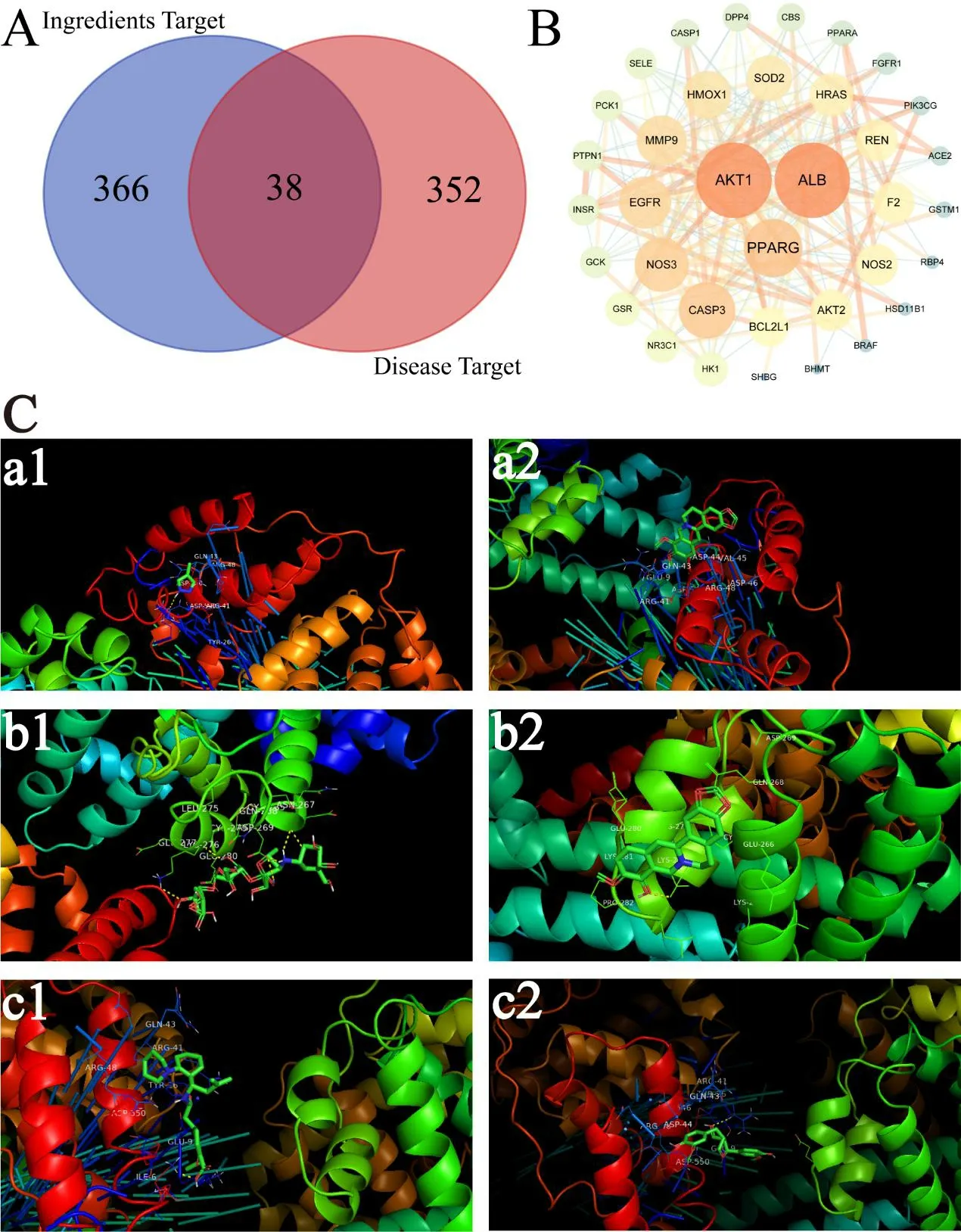
Figure 3 Network analysis results of blood composition of XXXD.A,acquisition of common targets;B,interaction diagram of target protein network of XXXD for the type 2 diabetes mellitus;C,molecular docking of three components from XXXD;a1,serine/threonine kinase 1 & positive drug fomepizole;a2,serine/threonine kinase 1 & berberine;b1,serum albumin & positive drug acarbose;b2,serum albumin & berberrubine;c1,serine/threonine kinase 1 & positive drug reginena;c2,serine/threonine kinase 1 & lariciresinol.XXXD,Xiaoxianxiong decoction.
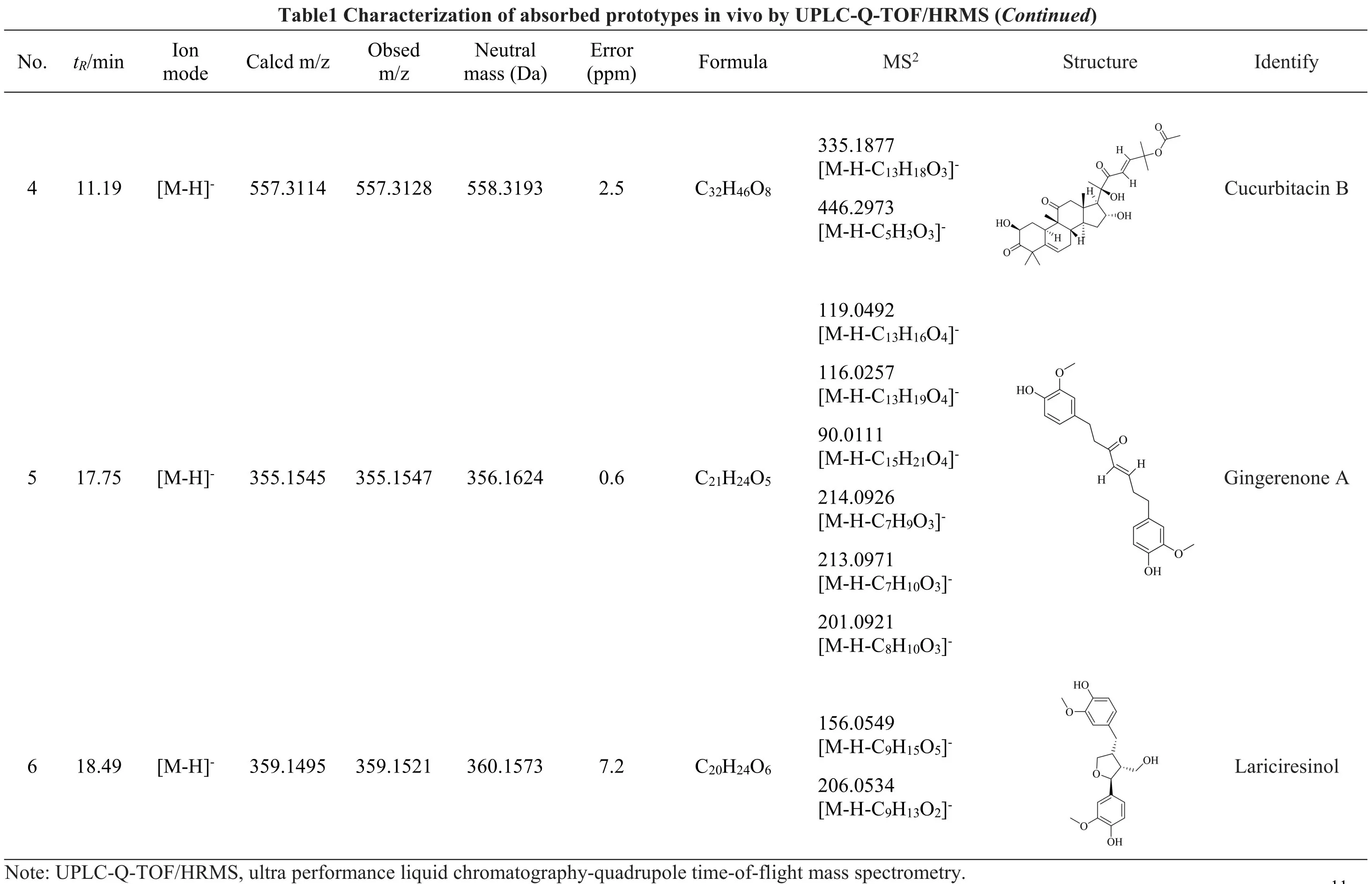
?
Molecular docking results
Molecular docking showed that the six absorbed prototype compounds in XXXD serum successfully docked with the receptors AKT1 and ALB.The docking details can be seen in Table 2,and interactive diagrams between three compounds and corresponding receptors can be seen in Figure 3.It is universally believed that a compound with binding energy(ΔGbind)more stable than that of the positive drugs can be considered as an active compound.Hence,theΔGbindof the positive drugs was set as the threshold for selecting active compound.Compared with the mean values of binding energy of positive drugs fomepizole,acarbose and repaglinide,4 compounds had excellent binding energy with two receptors among the 6 compounds,of which were berberine,berberrubine,lariciresinol inCoptidis rhizomaand gingerenone A inPinellia rhizome.
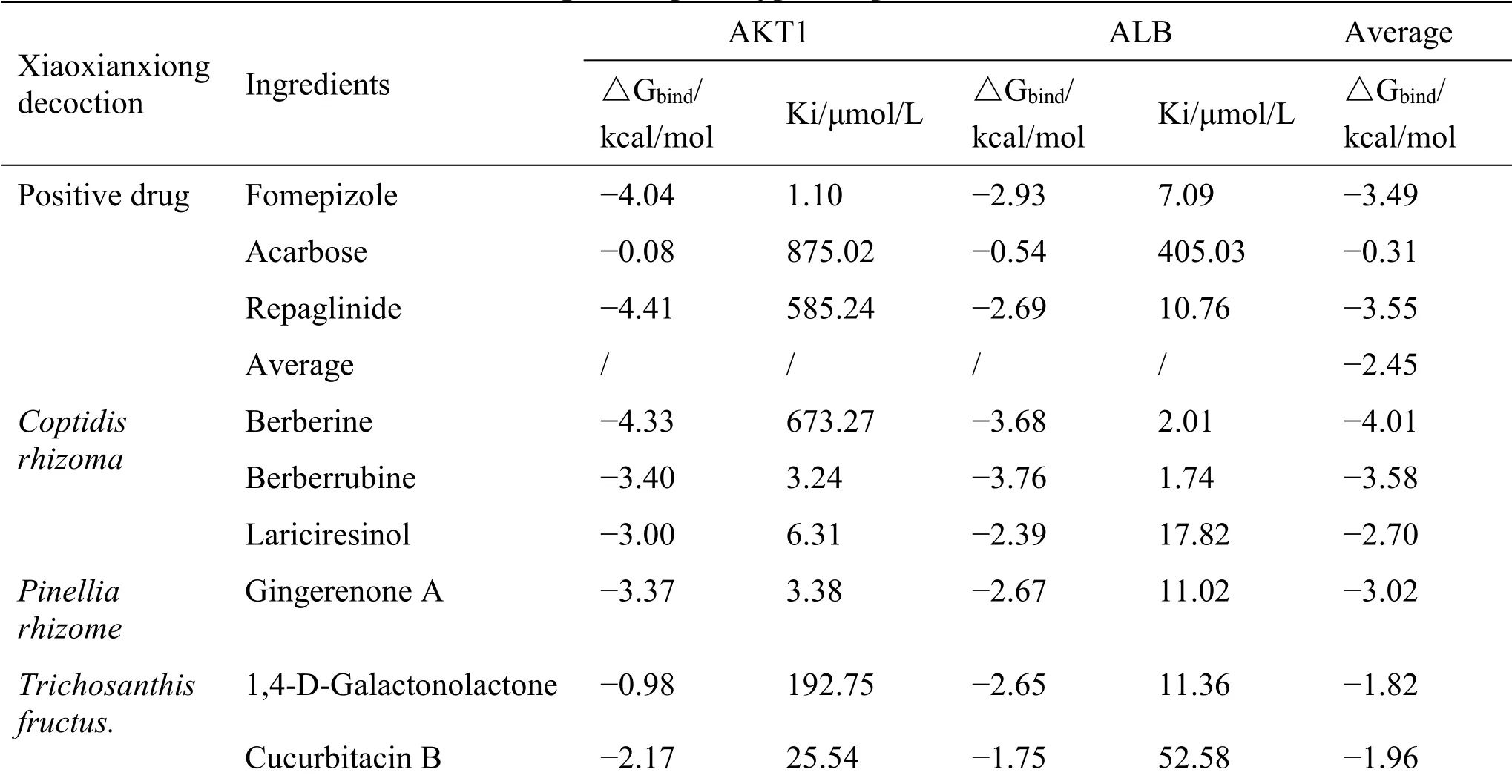
Table 2 Molecular docking of the prototype components of blood into the XXXD
Consequently,these four components were tentatively determined as potential material basis.Besides,jatrorrhizine was also identified as potential material basis because it sources from berberine which belong to the same composition group and exerts excellent hypoglycemic effect[32].In conclusion,the five absorbed chemical constituents were determined as potential material basis of XXXD treating T2DM.
Results of molecular mechanism
Acquisition results of direct targets of prototypes and metabolite.In a similar manner in“3.3.1”,a total of 367 direct targets were selected from 4 prototypes and one metabolite of berberine.
Acquisition results of direct common targets and indirect targets.By intersecting the direct targets obtained in“3.5.1”with the“T-T”targets,37 direct common targets were obtained,as shown in Figure 4A.The aforementioned direct common targets were imported into GeneMANIA database.As a result,20 indirect targets were obtained.By merging all direct common targets and indirect targets,a total of 57 potential targets were obtained.
Results of GO bioanalysis and pathway analysis.By importing 57 potential targets into STRING database,GO bioanalysis and pathway analysis were conducted.Furthermore,PPI was constructed,which was visualized by Cytoscape,involving 54 nodes and 308 edges and core targets AKT1 and ALB,as shown in Figure 4B.There were 815 groups of biological process,39 types of cellular component,100 entries of molecular function in GO bioanalysis results.The top 10 terms of the potential target protein in the treatment of T2DM is detailed in Figure 4(C-E).The biological function analysis was performed by Reactome database,revealing potential target protein of XXXD treating T2DM in Figure 4F.The yellow to brown lines represent the pathway of Chinese herbal medicine target enrichment.The larger theP-value,the darker the color.This figure shows that the targets mainly involves a great many of biological processes such as immune system,signal translation,gene expression(transcription),developmental biology and disease.
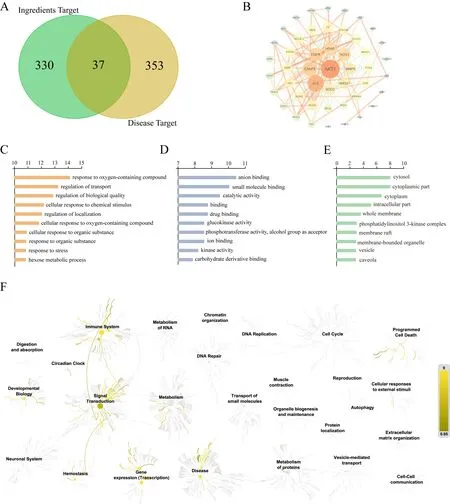
Figure 4 Network and GO enrichment analysis of molecular mechanism of Xiaoxianxiong Decoction treating T2DM.A,diagram of obtaining the direct targets;B,protein-protein interaction diagrams of the potential medicinal substance of XXXD to prevent type 2 diabetes mellitus;C,biological process analysis;D,molecular function analysis;E,cell composition analysis;F,biological function analysis chart of XXXD for prevention and treatment of type 2 diabetes mellitus potential target protein.XXXD,Xiaoxianxiong decoction.
GO analysis of 57 potential targets showed that 815GO terms were captured by biological process,mainly involving“response to oxygen containing compound”,“regulation of transport”,“regulation of biological quality”.The enrichment of molecular function generates 100 GO-terms,which are mainly closely related to“anion binding”,“small molecule binding”
and“catalytic activity”.A total of 39 GO-terms were obtained for cellular component,mainly including“cytosol”,“cytoplasmic part”,“cytoplasmic quality”and so on.
The KEGG and Reactome pathways analysis were performed,involving 144 biological pathways of KEGG and 139 biological pathways of Reactome.Among them,the first 30 paths in Reactome and in KEGG with high correlation were visually processed,as shown in Figure 5.The color represents theP-value,and the larger theP-value,the redder the color.In view of the pathway characteristics,KEGG pathway enrichment analysis results presented as follows.In present study,we just discussed the most closely related pathway with the occurrence and development of T2DM including signaling pathways and metabolic pathways while the disease pathways were excluded,such as pathways in cancer.Consequently,six pathways were found to be highly significant,namely,Insulin signaling pathway,HIF-1 signaling pathway,PI3K-Akt signaling pathway,FoxO signaling pathway,AGE-RAGE signaling pathway in diabetic complications,phospholipase D signaling pathway.Meanwhile,Reactome pathway analysis showed that XXXD significantly regulated T2DM in 6 pathways including Metabolism,Immune System,Signal Transduction,Glucose Metabolism,Apoptosis,Intrinsic pathway for apoptosis.
Construction of“TCM formula-herb-chemical composition-absorbed chemical constituent-direct target-indirect target-pathway”network.All the files were imported into Cytoscape to construct the network of “TCM formula-herb-chemical composition-absorbed chemical constituent-direct target-indirect target-pathway”,and the results were shown in Figure 6.The network consists of 312 nodes and 1,386 edges.This network reflects that XXXD preventing and treating T2DM characterized by multiple components,multiple targets and multiple pathways.
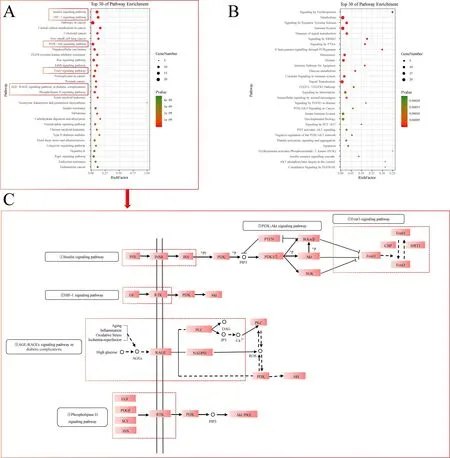
Figure 5 KEGG and Genomes analysis and Reactome analysis of type 2 diabetes mellitus potential target protein treated by XXXD.A,Kyoto Encyclopedia of Genes and Genomes pathway analysis;B,Reactome pathway analysis;C,6 key pathways with PI3K-Akt signaling pathway as the core via KEGG database.KEGG,Kyoto Encyclopedia of Genes;XXXD,Xiaoxianxiong decoction.
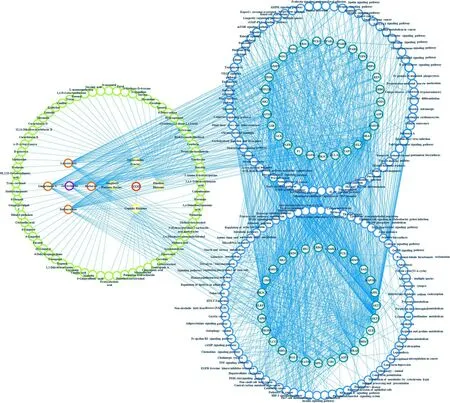
Figure 6“TCM formula-herb-chemical composition-absorbed chemical constituent-direct target-indirect target-pathway”network.Red node,Xiaoxianxiong decoction;yellow nodes,herbs;light green node,chemical compositions;orange node,absorbed prototype components;purple node,metabolites;dark green nodes,all targets;blue node,KEGG pathways.TCM,traditional Chinese medicine.KEGG,Kyoto Encyclopedia of Genes.
Discussion
The investigation of potential effective material basis
First,we employed chemomics for chemical compositions screening of XXXD,which provides an efficient and rapid method for the qualitative analysis and quality control.Then we introduced serum pharmacochemistry of TCM to identify the absorbed bioactive compounds after oral administration by UPLC-Q-TOF/HRMS and screening technology UNIFI platform.In result,the six absorbed prototypes and fifty-five metabolites sourced from berberine and berberrubine were identified.The six absorbed prototypes were berberrubine,berberine,lariciresinol,1,4-D-galactonolactone, cucurbitacin B, and gingerenone A.Among them,the absorption of berberine,berberrubine and Lariciresinol was reported previously[33,34],while the other three components were newly discovered in this study.Fianlly,we conducted molecular docking of the absorbed six prototypes and the active sites of core targets AKT1 and ALB which obtained using the topological analysis strategy to detect their interactions.In general berberine,berberrubine,lariciresinol and gingerenone A possessed higher binding energies towards the average value of positive drugs.Based on literature mentioned above[28],jatrorrhizine and the four compounds were identified as the potential effective material basis of XXXD against T2DM.It was gingerenone A that was found to be a new absorbed bioactive compound.Molecular docking technology is an effective way to identify drug targets and screen the potential candidate compounds by large-scale virtual screening,which can avoid the high cost of traditional effective substance and the shortage of analytical substances[35].
The aforementioned potential effective material basis had good biological activity related to lowering BG and lipids.XXXD regulates glucose and lipid metabolism mainly depending on Gingerenone A sourced fromPinellia rhizomeand berberine,berberrubine,lariciresinol,jatrorrhizine sourced fromCoptis Chinensis Franch.Berberine play a hypoglycemic effect and the possible mechanism mainly lies in promoting islet β cell regeneration and insulin release, inhibiting hepatic glycogen heterogenesis,promoting glycolysis and the secretion of small intestine glucagon-like peptide-1(GLP-1)[36,37].Berberrubine can commendably eliminate the total cholesterol and low density lipoprotein in the blood[38].Lariciresinol offers protective benefit against diabetes mainly attributed to the antioxidant properties[39].The hypoglycemic activity of jatrorrhizine was found to relate to the enhancement of aerobic glycolysis[28].Gingerenone A can inhibit S6K1 activity to improve insulin resistance and increase glucose uptake[40].Therefore,we performed network pharmacology analysis on potential effective material basis against T2DM at molecular level,which was effective to focus on specific targets and pathways to elucidate molecular mechanism.
XXXD attenuates the pathological changes of T2DM via regulating the PI3K-Akt signaling pathway
Insulin resistance and islet β cell dysfunction lead to abnormal metabolism of glucose,lipid and protein,which further leads to T2DM accompanied with insulin resistance in the whole process.“TypeⅡdiabetes mellitus”pathway also regulates adipocyte factor signaling pathway and insulin signaling pathway in view of KEGG.Therefore,it indirectly acts on insulin resistance pathway,promotes peroxidase proliferation,fatty acid metabolism,mitochondrial
β-oxidation to regulate glucose homeostasis,lipid homeostasis, proliferation differentiation,anti-apoptosis and other biological functions.The endocrine resistance mainly refers to insulin resistance.Insulin resistance(IR)refers to a metabolic state in which insulin sensitivity of the receptor organs,tissues or cells(such as skeletal muscle)decrease to the physiological concentration of insulin,the efficacy that insulin promotes the absorption and utilization of glucose by tissues and cells slows down,the compensatory secretion of insulin by the body increases,the glucose metabolism disorders,and causes BG increase[41].
PI3K-Akt signaling pathway is a key protein required by insulin to regulate cell metabolism.Many other growth factors,such as cytokines and environmental stress,can activate PI3K-Akt signaling pathway.PI3K(phosphatidylinositol 3-kinases),as the main downstream molecules of tyrosine kinase and G protein coupled receptor,catalyze the production of the second messenger 3,4,5-triphosphate phosphatidylinositol(PIP3),and then activate Akt,GSK-3,FoxO1,mammalian target of rapamycin(mTOR)and other downstream molecules,which transmit the signals of various growth factors and cytokines into cells,thus playing an important regulatory role in many biological processes such as cell proliferation,differentiation,apoptosis and glucose transport.In addition to insulin,the remaining five key pathways enriched in this study are related to PI3K-Akt through KEGG database,as shown in Figure 5C.The downstream regulatory pathways of endocrine resistance include several signaling pathways,such as FoxO signaling pathway,PI3K-Akt signaling pathway and etc,which directly regulates cell apoptosis and cell cycle,and regulates proliferation,differentiation,inflammation,gene expression and protein synthesis indirectly.The details are as follows.
Anti-inflammatory.The pathway analysis of 57 potential targets showed that XXXD had the characteristics of multiple components,multiple targets and multiple pathways in the prevention and treatment of type 2 diabetes.In terms of signaling pathway,insulin signaling pathway can regulate BG level through multiple signal transduction pathways and various biological processes,which activated two signaling pathway:MAPK and PI3K.MAPK is a kind of silk/threonine protein kinases widely existing in vivo,which can be activated by various extracellular stimuli,such as neurotransmitters,hormones and cellular stress.As a signaling pathway of MAPK family members,P38MAPK is closely related to the occurrence and development of diabetes.Wilmer et al.[42]demonstrated that cells cultured in vitro could activate the P38MAPK signaling pathway under long-term high glucose state.After being activated,P38MAPK regulates transcription factors and gene expression,which can further activate inflammatory cells and induce inflammatory tissue damage.Berberine can exert its anti-inflammatory activity by inhibiting the nuclear transcription of nuclear factor-κB(NF-κB)and the expression of pro-inflammatory cytokines,which can reduce oxidative stress and inflammatory response through certain common signaling pathways in cells,such as AMPK signaling pathway[43].
Cell cycle.Cell cycle including apoptosis,proliferation,differentiation,as one of the key pathways for insulin regulating BG balance in vivo,PI3K-Akt signaling pathway is crucial in the regulation of cell proliferation,movement,differentiation and survival.PI3K occupies an important part in the phosphokinase family,which can regulate cell growth and apoptosis.Akt is a serine/threonine kinase and one of the most important downstream effectors of PI3K.Phosphorylated Akt can further phosphorylate GSK-3,FoxOs,Bad,Caspase 9 and NF-κB,and then mediate cell growth,proliferation and glucose metabolism regulation induced by insulin and various growth factors[44].FoxOs belongs to the Forkhead protein family,involving FoxO1,FoxO3,FoxO4 and FoxO6.Among them,FoxO1 is mainly expressed in hepatocytes,adipocytes and islet β cells,FoxO1 phosphorylated by the PI3K-Akt signaling pathway is transported from the nucleus to the cytoplasm,resulting in reduced transcriptional activity and inhibition of gluconeogenesis and insulin resistance[45].Berberine can effectively inhibit the production of interleukin-6 and tumor necrosis factor-α,replace the expression of insulin receptor substrate 1 and PKB/Akt serine/threonine phosphorylation,thereby improving the insulin signal cascade and improving resistance[46].In high-fat diet-fed mice model,Gingerenone A could suppress obesity and adipose tissue inflammation[40].
Hypoxia inducible factor-1(HIF-1)[47]is a nuclear protein produced by tissue cells under hypoxia,which is a key substance for maintaining oxygen homeostasis.In hypoxia condition,HIF-1α is induced and vascular endothelial growth factor expression is further enhanced.Diabetic patients with long-term hyperglycemia could lead to mitochondrial respiratory chain damage,resulting in cell ischemia and hypoxia.The high expression of HIF-1α can increase supply of blood and oxygen,and maintain the metabolism of proliferating tissues,and thus promote the occurrence and development of diabetic proliferative lesions,such as diabetic retinopathy and diabetic cardiomyopathy.
Oxidative stress.AGE-RAGE signaling pathway plays an important role in the late stage of diabetes,when reducing sugars react with free amino groups of proteins and peptides to form advanced glycation end products(AGEs)[48].The binding of AGEs with receptor of AGEs(RAGE)will activate NF-κB,which can cause tissue inflammatory damage;and enhance the expression of transforming growth factor-β1 to cause tissue fibrosis,and activate nicotinamide adenine dinucleotide phosphate oxidase to induce oxidative stress.Lariciresinol,an active compound from Coptis chinensis,was reported to attenuate the pathological changes of diabetes contributing to its antioxidant effects[49].
Lipid regulation.Over 75% diabetic patients were afflicted by hyperlipidemia and hepatic steatosis which can further cause dyslipidemia.The effect that absorbed bioactive compounds of XXXD against T2DM could act on lipid signaling pathway[50].Ying-Hong Li et al.investigated the lipid-lowering efficacy of berberrubine in vivo[38].
Phospholipase D signaling pathway plays a role in the post-insulin signal transduction system,which is a basis of the transmembrane transport of glucose in target cells.Phosphorylation of IRSs activates PI3K,and thereby translocate glucose transporter(GLUT4)to the cell membrane so as to achieve glucose uptake.Glycosylphosphatidylinositol specific phospholipase D(GPI-PLD)synthesized and secreted by islet β cells can inhibit the formation of pancreatic amyloid fibrils in vitro,which will affect serum triglyceride metabolism and improve diabetes symptoms[51].In conclusion,phospholipase D can regulate T2DM by affecting glucose transporters and inhibiting the formation of amyloid fibrils.
Tricarboxylic acid cycle(TCA)cycle.In the light of KEGG pathway enrichment results shown in Supplemental File 2,there is three metabolic major pathways including TCA cycle,glycolysis/gluconeogenesis,pyruvate metabolism,and the latter two are part of the metabolism process of tricarboxylic acid cycle.
TCA cycle is the hinge of carbohydrate,lipid and amino acid metabolism.The first stage is glycolysis pathway,and the second stage is a series of reactions of pyruvate oxidation and decarboxylation to produce acetyl CoA and enters the TCA cycle.In first stage,glucose or glycogen undergoes aerobic oxidation and anaerobic fermentation.In aerobic oxidation,pyruvate is decarboxylated by pyruvate dehydrogenase to produce acetyl CoA,which then enters the TCA cycle to oxidize into carbon dioxide and water.Therefore,promoting TCA circulation can reduce BG level.The regulation of TCA cycle on glucose metabolism is not only the whole cycle,which can be considered as the overall regulation pathway of T2DM metabolism[52].Glycolysis/gluconeogenesis pathway mainly reflected in the change of metabolic concentration of glucose,deoxyglucose,glucuronic acid,etc.In addition to high glucose content in T2DM patients,fructose metabolism in the liver was damaged,and serum fructose concentration increased,which may also induce IR and affect glucose metabolism.In conclusion,the metabolism of T2DM is closely related to the development of glycolysis pathway.It was reported that the hypoglycemic activity of jatrorrhizine may owe to the enhancement of aerobic glycolysis[50].
Relevant biochemical substances,tissues and organs in the pyruvate metabolic pathway play an important role in the regulation of T2DM metabolism.Metabolomics research showed that pyruvate metabolic concentration in T2DM patients was 9.4 times higher than that in the control group[53].Obese T2DM patients are more likely to have lactic acid and pyruvate accumulation,which occurs only in mitochondria.Mitochondria are intermediate sites for the oxidation of nutrients in various metabolic pathways.Mitochondrial respiratory chain defects can affect the level of pyruvate,lactic acid and other metabolites.
In summary,five potential material bases mainly perform specific function including anti-inflammatory,promoting cell proliferation and differentiation,maintaining oxygen homeostasis and regulating lipid metabolism mainly phospholipase D in the signaling pathways.Meanwhile,insulin resistance affects the target tissue and organ,and the enzymes and key metabolites related to metabolic pathway mainly of TCA cycle play an important role in the development of T2DM.
The advantages and limitations
There are some advantages in present research.First,the chemical compositions of TCM formula can be studied quickly and systematically through high-throughput chemomics. Serum pharmacochemistry can quickly and accurately locate the effective material basis of TCM formula,and identify the direct acting substances in the complex system.The second is to apply computer to evaluate the molecular activity and reduce the number of compounds to be screened.And then analyzed by network pharmacology,predicting or verifying the target of compound theoretically.Afterwards,the network of “TCM formula-chemical compositions-targets-pathways”was established and pharmacological mechanism was explored systematically and scientifically on the basis of bioinformatics[54].The research of XXXD against T2DM,based on experiments and virtual screening methods,the accuracy of the potential effective material basis and molecular mechanism were verified scientifically and comprehensively.Not only the absorbed bioactive components were screened,but also the potential effective material basis was confirmed after docking with disease target[35].Furthermore,virtual screening focused on target proteins,pathways and biological functions to obtain an important molecular mechanism.It is of great reference value for further verification through pharmacological experiments and cell activity experiments.
However,there are still some limitations.Firstly,reference standards were not taken into account when identified the components in vivo,which may bring into incomplete results.Secondly,the potential material basis lies in physiological state,which are not entirely in accordance with pathological state.Thirdly,the screening of potential effective material basis is achieved by molecular docking.As a calculation method,the existing evaluation methods are relatively single,and there may be false positive results.Fourthly,the network pharmacology used in the quick exploration of molecular mechanism still lags behind the data of in vivo experiments,which need to be verified in combination with pharmacological tests.
Conclusion
Together,this paper aimed to explore the potential effective material basis and molecular mechanism.Finally,we identified 76 compounds from the compositions of XXXD.61 absorbed bioactive components were determined,among which 6 were prototype components and 55 were metabolites mainly sourced fromCoptidis rhizomaMolecular docking analysis showed that 5 compounds were considered as the potential effective material basis.On this basis,we employed network pharmacology to predict the potential target and pathways of XXXD.The mechanism of XXXD against T2DM mainly lies in the improvement of insulin resistance to regulate BG levels on target tissues as well as organs and exhibit inflammatory response,cell growth and proliferation,oxygen homeostasis and oxidative stress and affect the enzymes along with key metabolites.Accordingly,the integrated strategy possesses practical significance for the application and extension of other TCM formulae.
杂志排行
Traditional Medicine Research的其它文章
- Phytochemical composition,therapeutical and pharmacological potential of Nigella sativa:a review
- Network analysis and molecular docking of the mechanism of Shengmai decoction in treating patients with severe novel coronavirus pneumonia
- Study on possible synergistic anticancer cachexia effects of the main active compounds of Radix Sophorae flavescentis
- Traditional Chinese medicine of Salvia miltiorrhiza Bunge:a review of phytochemistry,pharmacology and pharmacokinetics
- Network pharmacology-based approach to investigate the mechanism of Huang-Lian-Jie-Du-Decoction for treatment of type 2 diabetes mellitus
- Pharmacological research progress of ursolic acid for the treatment of liver diseases
